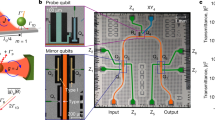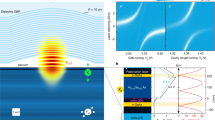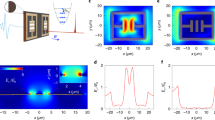Abstract
Optical nonlinearities offer unique possibilities for the control of light with light. A prominent example is electromagnetically induced transparency (EIT), where the transmission of a probe beam through an optically dense medium is manipulated by means of a control beam1,2,3. Scaling such experiments into the quantum domain with one (or just a few) particles of light and matter will allow for the implementation of quantum computing protocols with atoms and photons4,5,6,7, or the realization of strongly interacting photon gases exhibiting quantum phase transitions of light8,9. Reaching these aims is challenging and requires an enhanced matter–light interaction, as provided by cavity quantum electrodynamics10,11,12. Here we demonstrate EIT with a single atom quasi-permanently trapped inside a high-finesse optical cavity. The atom acts as a quantum-optical transistor with the ability to coherently control13 the transmission of light through the cavity. We investigate the scaling of EIT when the atom number is increased one-by-one. The measured spectra are in excellent agreement with a theoretical model. Merging EIT with cavity quantum electrodynamics and single quanta of matter is likely to become the cornerstone for novel applications, such as dynamic control of the photon statistics of propagating light fields14 or the engineering of Fock state superpositions of flying light pulses15.
This is a preview of subscription content, access via your institution
Access options
Subscribe to this journal
Receive 51 print issues and online access
$199.00 per year
only $3.90 per issue
Buy this article
- Purchase on Springer Link
- Instant access to full article PDF
Prices may be subject to local taxes which are calculated during checkout




Similar content being viewed by others
References
Harris, S. E. Electromagnetically induced transparency. Phys. Today 50, 36–42 (1997)
Lukin, M. D. Colloquium: trapping and manipulating photon states in atomic ensembles. Rev. Mod. Phys. 75, 457–472 (2003)
Fleischhauer, M., Imamoğlu, A. & Marangos, J. P. Electromagnetically induced transparency: optics in coherent media. Rev. Mod. Phys. 77, 633–673 (2005)
Werner, M. J. & Imamoğlu, A. Photon-photon interactions in cavity electromagnetically induced transparency. Phys. Rev. A 61, 011801 (1999)
Rebic, S., Tan, S. M., Parkins, A. S. & Walls, D. F. Large Kerr nonlinearity with a single atom. J. Opt. B 1, 490–495 (1999)
Bermel, P., Rodriguez, A., Johnson, S. G., Joannopoulos, J. D. & Soljačić, M. Single-photon all-optical switching using waveguide-cavity quantum electrodynamics. Phys. Rev. A 74, 043818 (2006)
Cardimona, D. A., Alsing, P. M., Mozer, H. & Rhodes, C. Interference effects in a three-level atom in a cavity beyond the weak-field approximation. Phys. Rev. A 79, 063817 (2009)
Hartmann, M. J., Brandao, F. G. S. L. & Plenio, M. B. Strongly interacting polaritons in coupled arrays of cavities. Nature Phys. 2, 849–855 (2006)
Greentree, A. D., Tahan, C., Cole, J. H. & Hollenberg, L. C. L. Quantum phase transitions of light. Nature Phys. 2, 856–861 (2006)
Imamoğlu, A., Schmidt, H., Woods, G. & Deutsch, M. Strongly interacting photons in a nonlinear cavity. Phys. Rev. Lett. 79, 1467–1470 (1997)
Grangier, P., Walls, D. F. & Gheri, K. M. Comment on “Strongly interacting photons in a nonlinear cavity”. Phys. Rev. Lett. 81, 2833–2833 (1998)
Imamoğlu, A., Schmidt, H., Woods, G. & Deutsch, M. Erratum: Strongly interacting photons in a nonlinear cavity. Phys. Rev. Lett. 81, 2836–2836 (1998)
Xu, X. et al. Coherent population trapping of an electron spin in a single negatively charged quantum dot. Nature Phys. 4, 692–695 (2008)
Rebić, S., Parkins, A. S. & Tan, S. M. Photon statistics of a single-atom intracavity system involving electromagnetically induced transparency. Phys. Rev. A 65, 063804 (2002)
Nikoghosyan, G. & Fleischhauer, M. Photon-number selective group delay in cavity induced transparency. Preprint at 〈http://arXiv.org/abs/0910.1900〉 (2009)
Santori, C. et al. Coherent population trapping of single spins in diamond under optical excitation. Phys. Rev. Lett. 97, 247401 (2006)
Xu, X. et al. Optically controlled locking of the nuclear field via coherent dark-state spectroscopy. Nature 459, 1105–1109 (2009)
Hwang, J. et al. A single-molecule optical transistor. Nature 460, 76–80 (2009)
Nußmann, S. et al. Submicron positioning of single atoms in a microcavity. Phys. Rev. Lett. 95, 173602 (2005)
Khudaverdyan, M. et al. Quantum jumps and spin dynamics of interacting atoms in a strongly coupled atom-cavity system. Phys. Rev. Lett. 103, 123006 (2009)
Kuhn, A., Hennrich, M. & Rempe, G. Deterministic single-photon source for distributed quantum networking. Phys. Rev. Lett. 89, 067901 (2002)
McKeever, J. et al. Deterministic generation of single photons from one atom trapped in a cavity. Science 303, 1992–1994 (2004)
Keller, M., Lange, B., Hayasaka, K., Lange, W. & Walther, H. Continuous generation of single photons with controlled waveform in an ion-trap cavity system. Nature 431, 1075–1078 (2004)
Wilk, T., Webster, S. C., Kuhn, A. & Rempe, G. Single-atom single-photon quantum interface. Science 317, 488–490 (2007)
Boozer, A. D., Boca, A., Miller, R., Northup, T. E. & Kimble, H. J. Reversible state transfer between light and a single trapped atom. Phys. Rev. Lett. 98, 193601 (2007)
Kimble, H. J. The quantum internet. Nature 453, 1023–1030 (2008)
Lukin, M. D., Fleischhauer, M., Scully, M. O. & Velichansky, V. L. Intracavity electromagnetically induced transparency. Opt. Lett. 23, 295–297 (1998)
Hernandez, G., Zhang, J. & Zhu, Y. Vacuum Rabi splitting and intracavity dark state in a cavity-atom system. Phys. Rev. A 76, 053814 (2007)
Wu, H., Gea-Banacloche, J. & Xiao, M. Observation of intracavity electromagnetically induced transparency and polariton resonances in a Doppler-broadened medium. Phys. Rev. Lett. 100, 173602 (2008)
Figueroa, E., Vewinger, F., Appel, J. & Lvovsky, A. I. Decoherence of electromagnetically induced transparency in atomic vapor. Opt. Lett. 31, 2625–2627 (2006)
Schuster, I. et al. Nonlinear spectroscopy of photons bound to one atom. Nature Phys. 4, 382–385 (2008)
Birnbaum, K. M. et al. Photon blockade in an optical cavity with one trapped atom. Nature 436, 87–90 (2005)
Kampschulte, T. et al. Optical control of the refractive index of a single atom. Preprint at 〈http://arxiv.org/abs/1004.5348〉 (2010)
Acknowledgements
We thank D. L. Moehring, H. P. Specht, C. Nölleke, A. Neuzner and C. Guhl for their contributions during the early stages of the experiment. This work was supported by the Deutsche Forschungsgemeinschaft (Research Unit 635) and the European Union (IST programmes SCALA and AQUTE). E.F. acknowledges support from the Alexander von Humboldt Foundation. C.J.V.-B. acknowledges support from Coordenação de Aperfeiçoamento de Pessoal de Nível Superior and the Brazilian National Institute for Science and Technology of Quantum Information (INCT-IQ).
Author information
Authors and Affiliations
Contributions
All authors contributed to the implementation and modelling of the experiment, the interpretation of the results and the writing of the manuscript.
Corresponding author
Ethics declarations
Competing interests
The authors declare no competing financial interests.
Rights and permissions
About this article
Cite this article
Mücke, M., Figueroa, E., Bochmann, J. et al. Electromagnetically induced transparency with single atoms in a cavity. Nature 465, 755–758 (2010). https://doi.org/10.1038/nature09093
Received:
Accepted:
Published:
Issue Date:
DOI: https://doi.org/10.1038/nature09093
This article is cited by
-
A subwavelength atomic array switched by a single Rydberg atom
Nature Physics (2023)
-
Many-body cavity quantum electrodynamics with driven inhomogeneous emitters
Nature (2023)
-
Non-Hermitian control between absorption and transparency in perfect zero-reflection magnonics
Nature Communications (2023)
-
Mechanically controlled quantum memory efficiency and optical transistor
Quantum Information Processing (2023)
-
Two-channel cross-phase modulation based on the reversible storage of light in a cold atomic system
Indian Journal of Physics (2022)
Comments
By submitting a comment you agree to abide by our Terms and Community Guidelines. If you find something abusive or that does not comply with our terms or guidelines please flag it as inappropriate.



